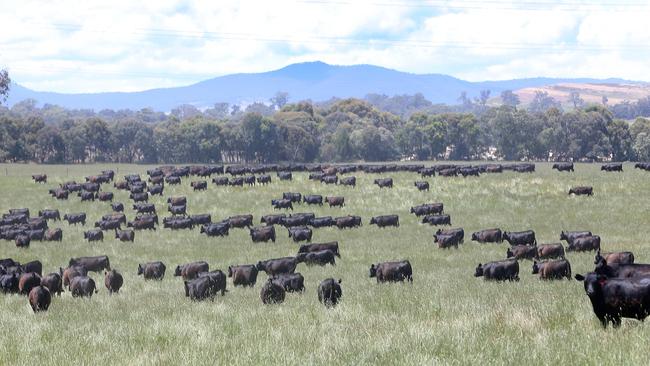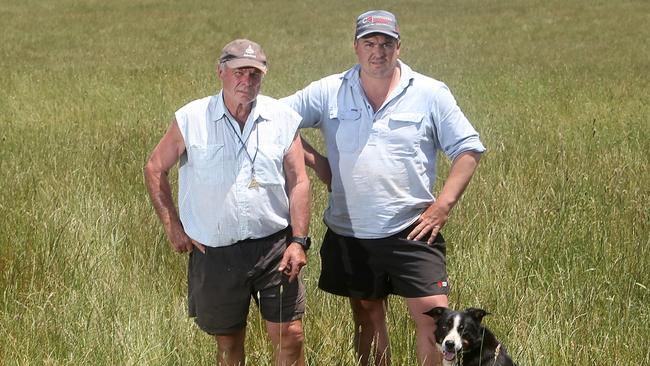Rod and Rodda Manning from Davilak Pastoral finely tuned beef operation
This Angus powerhouse has mastered the art of producing some of the weaner calves in southern Australia and turning off grassfed cattle.
Operating a successful beef business is a numbers game for more than one reason for the Manning family.
Father-and-son Rod and Rodda Manning run more than 2000 Angus females across six properties within a 60km radius of Mansfield in Victoria’s North East. They may be best known for their annual draft of several hundred steer weaners sold each January under their Davilak Pastoral trading name, but it’s only one output from a finely-tuned beef operation which is hyper vigilant about numbers.
Rod, who trained and worked as a veterinarian and farm consultant, first bought land in 1976, taking on about 100ha and running 40 Angus cows.
That land area has gradually scaled up to its current size of 2200ha of freehold and another 200ha of rougher lease country to run the Angus herd, and has been managed over the past 10 years by Rodda as manager of operations.
The increase in size has been deliberate as the operation chases economy of scale while at the same time focusing on a high-quality output.
Genetics play a big role in this, and Rod said they purchased all their bulls from Glendaloch Angus stud at Yea. The Mannings buy 15-month-old replacements for the 70-strong bull team with the aim of only keeping them for two to three joinings, which effectively shortens the generational interval and increases genetic gain
“We do not look for extreme bulls, and we piggyback on the genetic progress being made at Glendaloch,” Rod said. “We are after an even line of cattle.”

QUALITY FOCUS
Such is the size of the Mannings’ mostly autumn-calving herd, and the evenness of the line of weaners they breed, that they have a high retention rate of the heifers, which has two benefits.
“All the time, we are trying to improve the overall quality of our herd, and if we have big numbers of young heifers coming up, we can sell older non-performing cows and exert higher selection pressure, without affecting our overall female numbers,” Rod said.
In turn, the sheer number of heifers coming into the herd means a big number of older cows exiting at the other end of the production system and, this year, that too has been a more than handy cash injection with the cows averaging $2200-$2300 at 650kg liveweight.
But high heifer numbers create flexible production systems and that has allowed the operation to expand rapidly when more land is bought. The culling rate of the older cows is cut back to allow immediate stocking of the property without any extra outlay.
Any heifers which do not make the grade for joining are grown out to fit the Coles grid and sold at about 500kg liveweight into the Coles Graze program.
Rod said this had been a big positive for the business because it evened out cash flow, as they were sold at a different time to the major income stream which is the sale of steer weaners each January.
And while genetics play a role, it is no accident the steer calves present well each summer; heifers have high conception rates; calving difficulties are kept to a minimum and cows maintain condition.
And it centres around the management of grass.

FEED FOR THOUGHT
Feed on the 780-800mm rainfall country is the key to making everything else tick, as is knowing the value of that feed and how it can influence the beef production system.
Drawing on their knowledge of energy requirements at various stages of either growth or pregnancy, Rod and Rodda allocate feed according to the class of animal using it.
The secret is matching the feed on offer to the animals’ requirements to optimise production
The cattle are run in paddocks which are 18-22ha, and are rotationally grazed with movements about every three to five days.
This maximises the dry matter production even through winter from their phalaris-based pastures, which are mostly the Holdfast GT variety.
“Soil temperatures in winter at Mansfield can get down to 6C and ryegrass pastures will produce 7-10kg/ha dry matter/ha in this cold weather but phalaris, as long as it is fed (nutrients) will produce 18-22kg/ha of dry matter,” Rod said.
“As land becomes more expensive and we still want to expand and work on our economies of scale, we need to be looking at the amount of dry matter per hectare we are producing rather than simply buying more land.”
Growing and using feed efficiently underpins key decisions at Davilak, with heifer conception rates a clear example.
High conception rates in 15-month-old heifers are no accident with the operation consistently achieving 85-90 per cent and this year, 92 per cent. To realise this, the Mannings know they need to have their heifers weighing at least 325kg at mating and preferably closer to 350kg.
“This is a critical point we work towards, so we will weigh and measure those 15-month-old heifers prior to joining and allocate them a feed budget of 85 megajoules of energy per day, knowing they will put on 1.1kg a day and will reach the target joining rate,” Rod said.
“We know the energy requirements (megajoules) that the cattle need at various stages of growth and pregnancy so allocate paddocks and feed with this in mind.
“We want to be growing big amounts of dry matter - an average farm producing 5000kg of dry matter per hectare and utilising say 33 per cent of this is producing around 17000 megajoules of energy/hectare harvested.
“A farm next door could be producing 8000-10,000kg of dry matter per hectare and utilising say 50 per cent through a much tighter grazing strategy, and harvest around 50,000 megajoules of energy or three times as much per hectare.
“We need to be in this higher producing group, to be able to maximise stocking rates within our operation.”

MANAGING RISK
As stocking rates rise, so does the risk profile so there is the need to develop a whole new raft of management procedures’ to counter this, particularly when it comes to climate variation.
Rod said it was about being prepared for tough seasons which could reduce the amount of dry matter produced.
There are two ways the Mannings cope with this — they put money aside during good times in Farm Management Deposits to call on to buy supplementary feed to keep herd numbers solid. They also make sure that their cost of production is as low as possible.
Their most recent calculation is that it costs Davilak $1.40/kg of beef produced out the gate (including finance costs) and this is achieved by economy of scale, efficient labour and good infrastructure and use computer modelling for drought feeding regimes.
“Where we can take control is in our cost of production — we can’t worry about prices,” Rod said. “You need to know your cost of production and to know what are sensible decisions in terms of expenditure and what are not.
“If prices come back, we know that at $1.40kg we can still make money if rates slipped back to $4 or $3.50/kg but if our costs of production were $3/kg, then a price dip could put big pressure on your business.
“We have an excellent accountant and he provides objective financial advice on a regular basis which is extraordinary valuable to our business.”

WELFARE CHAMPIONS
While numbers and facts are king for the Mannings, it is never at the cost of their attention to the welfare and well being of their cattle.
Rodda runs much of the day-to-day management of the operation, and keeps a careful eye and an open mind on doing thing better on a daily basis
The annual weaning program is a case in point.
With literally thousands of calves to manage, the five-day stint in the weaning yards was creating some issues with animal-health challenges such as pink eye and a level of stress.
Here, Rodda changed strategies, and allows the calves to spend a few hours in a small nearby paddock on a daily basis during the weaning program.
“There is always some stress during weaning, as they are taken from their mothers and they go onto a new feed (silage, hay and grain-free pellets) fed in troughs,” Rodda said.
“We just felt if we could let them go into a paddock for a little while each day could help them and while we have not weighed the to see if there is a difference, they certainly seem to settle better and at the end of those five days, just wander out of the yards.
“We get excellent feedback about how our cattle are quiet and well-handled and we want to know that our buyers are happy with what they get and want them to come back and buy again.”




